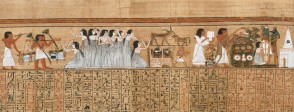Look at the image of Ani’s funeral procession, and ask the students to identify the following people: Ani; his wife Tutu; family members (including an elder with white hair); Ani’s son wearing a panther skin; female mourners; lector-priest with a scroll; priest dressed as Anubis; servants carrying Ani’s belongings. Use the information in About the object to discuss the roles these different people played in the funeral.
Ask the class if anything about the funeral reminds them of how people behave at funerals now. Do people still do the same things? If appropriate, ask students to share how funerals are celebrated in different communities.
Look at the images of the funeral procession with the class and ask them to find the objects Ani wanted to take to the next life: his bed and chair; scribes’ equipment, etc. What do they think is inside the boxes? What would they choose to take to the afterlife? Watch the video clip in For the classroom and compare the tomb scene with Ani’s funeral.
Help the students understand the purpose of the Book of the Dead. Ask them to imagine going on a journey to a place they have never been before. How could they find their way? What would help: a guidebook, maps, pictures, signs? Is there anyone they could ask, for example police, tourist information? What dangers might they face, for example, busy roads, unfamiliar situations? How could they make sure of getting to their destination safely?
The following activities explore aspects of Egyptian afterlife beliefs raised by Ani’s Book of the Dead. Use the resources in For the classroom and the hundreds of images available on the British Museum website and the internet to broaden the enquiry. Each activity involves initial research leading on to creative activities.
Look closely at the Opening of the Mouth ceremony of Hunefer in For the classroom. Look at the equipment and adze used in the ceremony. Can the students find any of these in the painting? Read the story of Osiris and explain how this ritual relates to it. The story and the ceremony lend themselves to drama work. Students could also make an Anubis mask or mummy mask using paper maché or found materials.
Use the resources in A bigger picture and the interactive game in For the classroom to explore Ani and his wife Tutu’s journey through the Underworld to the court of Osiris. Ask students to imagine they are following them and write a narrative of the journey, describing the strange sights and sounds they encounter on the way.
Look at the Weighing of the Heart of Ani in A bigger picture – just identify everything the students can see without interpretation at this stage. Show the class the two video clips about the Weighing of the Heart in For the classroom. One of these shows the scene carved on the walls of a tomb. Go back to Ani’s scene and ask the students to identify and label the following: Ani, his wife Tutu, Ani’s heart, the feather of Truth, Anubis, Thoth, the Devourer. The idea of the balance can also be used for weighing and measuring activities, and for balancing equations in mathematics.
Use the resources in A bigger picture and For the classroom to explore what scarabs are and how the Egyptians came to identify them with rebirth. Explain why the heart scarab was so important for the judgment of the dead. Read the class the heart scarab text in More information. Do students think using magic to survive judgment was cheating? Allow students to make their own heart scarabs with clay.
Explore the images of the Field of Reeds with the class. Discuss the Egyptians’ idea of the next world and ask students to compare it with other ideas about paradise. Show the class the video clips about shabtis in For the classroom. They could make their own shabtis using air-drying clay.
Working in groups, students could make a wall frieze or digital presentation showing Ani’s journey from his house to the Field of Reeds. This could be done in the style of a papyrus scroll.


